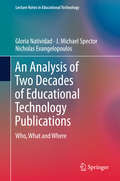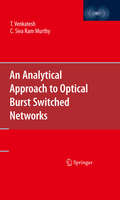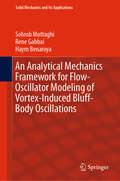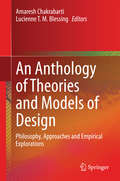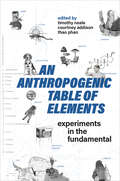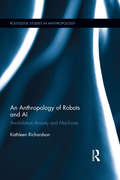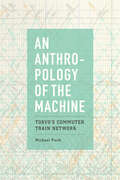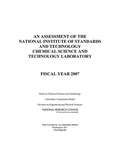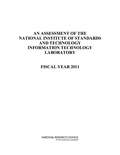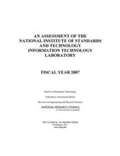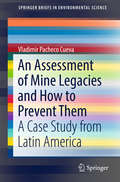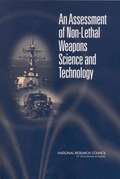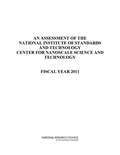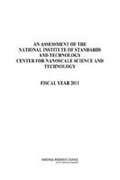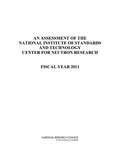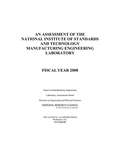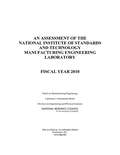- Table View
- List View
An American Railroad Dream: My Career As A Locomotive Engineer
by Susie Gaglia Patrick MorrisonSusie Gaglia reminisces about fulfilling her childhood dream with her career as railroad engineer for passenger and freight trains along the Northeast Corridor during the mid twentieth century. Beginning with her upbringing in a suburb of Buffalo through the process of qualifying to operate locomotives to vignettes from her fifteen-year career, Susie remembers kind mentors, close encounters on the tracks, near misses, massive accidents, and moments of sexual harassment as she fulfilled an American railroad dream.
An Analysis of Two Decades of Educational Technology Publications: Who, What And Where (Lecture Notes In Educational Technology)
by J. Michael Spector Nicholas Evangelopoulos Gloria NatividadProvides a comprehensive and up-to-date review of educational technology research articles.<P><P> Presents a clustered analysis showing the trends over the last 20 years.<P> Discusses the leading authors and journals in the subject area.<P> This book presents a challenging and multi-faceted research project that required state-of-the-art methodological approaches. The project involved analyzing data collected from 10,000 research articles published in ten leading journals in the area of educational technology over 20 years, from January 1994 to December 2014; advanced analytic approaches such as latent semantic analysis; and expert insights and interpretations of the subject matter.<P> It captures the trends in a number of research streams within the discipline of educational technology and identifies the point in time when a massive change took place. This is a significant achievement given that, in epistemology and philosophy of science, there have always been discussions of paradigm shifts, but researchers have always identified them qualitatively. This is the first work to identify a paradigm shift using rigorous quantitative methods. <P> The analysis procedure involved big data and sophisticated analysis, which supported the identification of clusters at several breakpoints from which the richest set was selected in order to provide the most detailed analysis. This comprehensive analysis also shows what has been published and by whom in those ten top-tier journals. This work makes a highly significant contribution to the field of learning technologies and provides the groundwork and a significant data source for other scholars, both new and experienced, to build on and expand in their work.
An Analytical Approach to Optical Burst Switched Networks
by C. Siva Murthy T. VenkateshThis book presents the state of the art results on modeling and analysis of OBS networks. It provides researchers with new directions for future research and helps them gain a better understanding of modeling OBS networks. This book classifies all the literature on modeling and analysis of OBS networks and serves as a thought provoking material for the researchers working on the analysis of high-speed networks. The scope of this book however is not limited to OBS networks alone but extends to high-speed communication networks with limited or no buffers.
An Analytical Mechanics Framework for Flow-Oscillator Modeling of Vortex-Induced Bluff-Body Oscillations (Solid Mechanics and Its Applications #260)
by Haym Benaroya Sohrob Mottaghi Rene GabbaiThis self-contained book provides an introduction to the flow-oscillator modeling of vortex-induced bluff-body oscillations. One of the great challenges in engineering science also happens to be one of engineering design – the modeling, analysis and design of vibrating structures driven by fluid motion. The literature on fluid–structure interaction is vast, and it can be said to comprise a large fraction of all papers published in the mechanical sciences. This book focuses on the vortex-induced oscillations of an immersed body, since, although the importance of the subject has long been known, it is only during the past fifty years that there have been concerted efforts to analytically model the general behavior of the coupling between vortex shedding and structural oscillations. At the same time, experimentalists have been gathering data on such interactions in order to help define the various regimes of behavior. This data is critical to our understanding and to those who develop analytical models, as can be seen in this book. The fundamental bases for the modeling developed in this book are the variational principles of analytical dynamics, in particular Hamilton’s principle and Jourdain’s principle, considered great intellectual achievements on par with Newton’s laws of motion. Variational principles have been applied in numerous disciplines, including dynamics, optics and quantum mechanics. Here, we apply variational principles to the development of a framework for the modeling of flow-oscillator models of vortex-induced oscillations.
An Anthology of Theories and Models of Design: Philosophy, Approaches and Empirical Explorations
by Amaresh Chakrabarti Lucienne T. M. BlessingWhile investigations into both theories and models has remained a major strand of engineering design research, current literature sorely lacks a reference book that provides a comprehensive and up-to-date anthology of theories and models, and their philosophical and empirical underpinnings; An Anthology of Theories and Models of Design fills this gap. The text collects the expert views of an international authorship, covering: #65533; significant theories in engineering design, including CK theory, domain theory, and the theory of technical systems; #65533; current models of design, from a function behavior structure model to an integrated model; #65533; important empirical research findings from studies into design; and #65533; philosophical underpinnings of design itself. For educators and researchers in engineering design, An Anthology of Theories and Models of Design gives access to in-depth coverage of theoretical and empirical developments in this area; for practitioners, the book will provide exposure to theoretical and empirical foundations to methods and tools that are currently practiced as well as those in the process of development.
An Anthropogenic Table of Elements: Experiments in the Fundamental (Technoscience and Society)
by Timothy Neale Courtney Addison Thao PhanAn Anthropogenic Table of Elements provides a contemporary rethinking of Dmitri Mendeleev’s periodic table of elements, bringing together "elemental" stories to reflect on everyday life in the Anthropocene. Concise and engaging, this book provides stories of scale, toxicity, and temporality that extrapolate on ideas surrounding ethics, politics, and materiality that are fundamental to this contemporary moment. Examining elemental objects and forces, including carbon, mould, cheese, ice, and viruses, the contributors question what elemental forms are still waiting to emerge and what political possibilities of justice and environmental reparation they might usher into the world. Bringing together anthropologists, historians, and media studies scholars, this book tests a range of possible ways to tabulate and narrate the elemental as a way to bring into view fresh discussion on material constitutions and, thereby, new ethical stances, responsibilities, and power relations. In doing so, An Anthropogenic Table of Elements demonstrates through elementality that even the smallest and humblest stories are capable of powerful effects and vast journeys across time and space.
An Anthropology of Robots and AI: Annihilation Anxiety and Machines (Routledge Studies in Anthropology #20)
by Kathleen RichardsonThis book explores the making of robots in labs at the Massachusetts Institute of Technology (MIT). It examines the cultural ideas that go into the making of robots, and the role of fiction in co-constructing the technological practices of the robotic scientists. The book engages with debates in anthropological theorizing regarding the way that robots are reimagined as intelligent, autonomous and social and weaved into lived social realities. Richardson charts the move away from the “worker” robot of the 1920s to the “social” one of the 2000s, as robots are reimagined as companions, friends and therapeutic agents.
An Anthropology of Robots and AI: Annihilation Anxiety and Machines (Routledge Studies in Anthropology)
by Kathleen RichardsonThis book explores the making of robots in labs at the Massachusetts Institute of Technology (MIT). It examines the cultural ideas that go into the making of robots, and the role of fiction in co-constructing the technological practices of the robotic scientists. The book engages with debates in anthropological theorizing regarding the way that robots are reimagined as intelligent, autonomous and social and weaved into lived social realities. Richardson charts the move away from the “worker” robot of the 1920s to the “social” one of the 2000s, as robots are reimagined as companions, friends and therapeutic agents.
An Anthropology of the Machine: Tokyo's Commuter Train Network
by Michael Fisch“An astute account of [Tokyo’s] commuter train network . . . and an intellectually stimulating invitation to rethink the interaction between humans and machines.” —Japan ForumWith its infamously packed cars and disciplined commuters, Tokyo’s commuter train network is one of the most complex technical infrastructures on Earth. In An Anthropology of the Machine, Michael Fisch provides a nuanced perspective on how Tokyo’s commuter train network embodies the lived realities of technology in our modern world. Drawing on his fine-grained knowledge of transportation, work, and everyday life in Tokyo, Fisch shows how fitting into a system that operates on the extreme edge of sustainability can take a physical and emotional toll on a community while also creating a collective way of life—one with unique limitations and possibilities.An Anthropology of the Machine is a creative ethnographic study of the culture, history, and experience of commuting in Tokyo. At the same time, it is a theoretically ambitious attempt to think through our very relationship with technology and our possible ecological futures. Fisch provides an unblinking glimpse into what it might be like to inhabit a future in which more and more of our infrastructure—and the planet itself—will have to operate beyond capacity to accommodate our ever-growing population.“Not a ‘rage against the machine’ but an urge to find new ways of coexisting with technology.” —Contemporary Japan“An extraordinary study.” —Ethnos“A fascinating in-depth account of the innovations, inventions, sacrifices, and creativity required to ensure Tokyo’s millions of commuters keep rolling. It also provides much food for thought as our transportation systems become increasingly reliant on automated technology.” —Pacific Affairs
An Approach to Improving Decision-Making in Wetland Restoration and Creation: An Approach To Improving Decision Making In Wetland Restoration And Creation
by Mary E. KentulaAn Approach to Improving Decision-Making in Wetland Restoration and Creation succinctly compares populations of natural and created wetlands to determine whether restored wetlands successfully replace wetlands lost to development or other pressures. The book also presents strategies for mitigation of wetland losses, site selection for wetland restoration projects, and assessment of the level of attainable function for restored wetlands. The book is a significant resource for helping wetland professionals, planners, and ecologists formulate decisions affecting the creation and restoration of wetlands.
An Assessment Of The National Institute Of Standards And Technology Building And Fire Research Laboratory: Fiscal Year 2008
by National Research Council of the National AcademiesA panel of experts appointed by the National Research Council assessed the scientific and technical work of the Building and Fire Research Laboratory (BFRL) of the National Institute of Standards and Technology (NIST). The scope of the assessment included the following criteria: (1) the technical merit of the current laboratory programs relative to the current state of the art worldwide; (2) the adequacy of the laboratory facilities, equipment, and human resources, as they affect the quality of the laboratory technical programs; and (3) the degree to which the laboratory programs in measurement science and standards achieve their stated objectives and desired impact. The book finds that, overall the technical merit of the programs reviewed within the BFRL is very high and generally at a state-of-the-art level. The programs have clear ties to the overall BFRL Strategic Priority Areas and are well aligned with the mission of NIST, which is to promote U.S. innovation and industrial competitiveness by advancing measurement science, standards, and technology in ways that enhance economic security and improve our quality of life.
An Assessment Of The National Institute Of Standards And Technology Chemical Science And Technology Laboratory: Fiscal Year 2007
by National Research Council of the National AcademiesThe report on the CSTL presents an assessment of the Lab’s five divisions, covering—where appropriate—how well each division addresses national priorities, its impact and level of innovation, its technical merit, and its infrastructure. The report notes that the CSTL is meeting its obligations and its priorities are appropriate and aligned with national priorities.
An Assessment Of The National Institute Of Standards And Technology Electronics And Electrical Engineering Laboratory: Fiscal Year 2007
by National Research Council of the National AcademiesThe report on the EEEL presents an assessment of the Lab’s four divisions. The assessment is based on four criteria: alignment with national priorities, motivation of its programs, technical merit, and technical program quality. The report also provides a look at three additional concerns: staffing and funding, international issues, and the planning process.
An Assessment Of The National Institute Of Standards And Technology Information Technology Laboratory
by The National Academy of SciencesSince 1959, the National Research Council (NRC), at the request of the National Institute of Standards and Technology (NIST), has annually assembled panels of experts to assess the quality and effectiveness of the NIST measurements and standards laboratories. In 2011, the NRC evaluated three of the six NIST laboratories: the Center for Nanoscale Science and Technology (CNST), the NIST Center for Neutron Research (NCNR) and the Information Technology Laboratory (ITL). Each of these was addressed individually by a separate panel of experts; this report assesses ITL.
An Assessment Of The National Institute Of Standards And Technology Information Technology Laboratory: Fiscal Year 2007
by National Research Council of the National AcademiesThe report on the ITL presents a general assessment of the laboratory including a look at its research strategies, opportunities, planning for growth, research culture, and computing infrastructure; and provides assessments of the laboratory’s six divisions. The report notes that the work of the ITL generally ranks at or near the top of the work being done by peer institutions.
An Assessment Of The Sbir Program At The National Science Foundation
by National Research Council of the National AcademiesThe Small Business Innovation Research (SBIR) program is one of the largest examples of U.S. public-private partnerships. Founded in 1982, SBIR was designed to encourage small business to develop new processes and products and to provide quality research in support of the many missions of the U.S. government, including health, energy, the environment, and national defense. In response to a request from the U.S. Congress, the National Research Council assessed SBIR as administered by the five federal agencies that together make up 96 percent of program expenditures. This book, one of six in the series, reports on the SBIR program at the National Science Foundation. The study finds that the SBIR program is sound in concept and effective in practice, but that it can also be improved. Currently, the program is delivering results that meet most of the congressional objectives, including stimulating technological innovation, increasing private-sector commercialization of innovations, using small businesses to meet federal research and development needs, and fostering participation by minority and disadvantaged persons. The book suggests ways in which the program can improve operations, continue to increase private-sector commercialization, and improve participation by women and minorities.
An Assessment of Mine Legacies and How to Prevent Them: A Case Study from Latin America (SpringerBriefs in Environmental Science)
by Vladimir Pacheco CuevaThis book seeks to enrich the growing literature on mine legacies by examining a case study of a small abandoned mine in Latin America. Using a combination of Rapid Rural Appraisal and secondary source analysis, this study assessed some of the most damaging legacies of the San Sebastian mine in eastern El Salvador, compared the country's mine closure legislation against world's best practice standards and provided strategies for awareness, prevention and remediation. The most damaging legacy to the environment is that of Acid Mine Drainage (AMD) contamination of the local river. The impact of AMD is felt well beyond the mining district and the costs of prevention and remediation were found to be significant. Apart from environmental legacies, the mine also left a number of socio-economic legacies including: limited access to non-polluted water that results in San Sebastian residents devoting a high proportion of their income in obtaining water, lost opportunities due to the cessation of mining, uncertain land tenure situation and increasing growth of ASGM activities that exacerbate already existing environmental pollution due to use of mercury. The study also found that the state's capacity to ensure compliance with the law is very weak and that in many important respects the country's current legal framework does not meet world's best practice when it comes to mine closure requirements. The findings are important because they demonstrate that the lack of closure planning can lead to private operators socializing the costs of pollution. The study also shows that the lack of state capacity may result in extractive projects becoming socio-economic liabilities in the long term.
An Assessment of Non-Lethal Weapons Science and Technology
by Technology Committee for an Assessment of Non-Lethal Weapons ScienceNon-lethal weapons (NLWs) are designed to minimize fatalities and other undesired collateral damage when used. Events of the last few years including the attack on the USS Cole have raised ideas about the role NLWs can play in enhancing support to naval forces. In particular to what extent and in what areas should Department of the Navy (DoN) -sponsored science and technology (S&T) provide a research base for developing NLW capabilities? To assist with this question and to evaluate the current NLWs program, the Joint Non-Lethal Weapons Directorate (JNLWD) and the Office of Naval Research (ONR) requested the National Research Council perform an assessment of NLWs science and technology. The report presents the results of that assessment. It discusses promising NLW S&T areas, development accomplishments and concerns about NLW, and series of recommendations about future NLW development and application.
An Assessment of the National Institute of Standards and Technology Building and Fire Research Laboratory: Fiscal Year 2010
by National Research Council of the National AcademiesA panel of experts appointed by the National Research Council assessed the scientific and technical work of the Building and Fire Research Laboratory (BFRL) of the National Institute of Standards and Technology (NIST). The scope of the assessment included the following criteria: (1) the technical merit of the current laboratory programs relative to the current state of the art worldwide; (2) the adequacy of the laboratory facilities, equipment, and human resources, as they affect the quality of the laboratory technical programs; and (3) the degree to which the laboratory programs in measurement science and standards achieve their stated objectives and desired impact.
An Assessment of the National Institute of Standards and Technology Center for Nanoscale Science and Technology
by The National Academy of SciencesSince 1959, the National Research Council (NRC), at the request of the National Institute of Standards and Technology (NIST), has annually assembled panels of experts to assess the quality and effectiveness of the NIST measurements and standards laboratories. In 2011, the NRC evaluated three of the six NIST laboratories: the Center for Nanoscale Science and Technology (CNST), the NIST Center for Neutron Research (NCNR) and the Information Technology Laboratory (ITL). Each of these was addressed individually by a separate panel of experts; this report assesses CNST.
An Assessment of the National Institute of Standards and Technology Center for Nanoscale Science and Technology: Fiscal Year 2011
by Technology Panel on Nanoscale ScienceSince 1959, the National Research Council (NRC), at the request of the National Institute of Standards and Technology (NIST), has annually assembled panels of experts to assess the quality and effectiveness of the NIST measurements and standards laboratories. In 2011, the NRC evaluated three of the six NIST laboratories: the Center for Nanoscale Science and Technology (CNST), the NIST Center for Neutron Research (NCNR) and the Information Technology Laboratory (ITL). Each of these was addressed individually by a separate panel of experts; this report assesses CNST.
An Assessment of the National Institute of Standards and Technology Center for Neutron Research
by The National Academy of SciencesSince 1959, the National Research Council (NRC), at the request of the National Institute of Standards and Technology (NIST), has annually assembled panels of experts to assess the quality and effectiveness of the NIST measurements and standards laboratories. In 2011, the NRC evaluated three of the six NIST laboratories: the Center for Nanoscale Science and Technology (CNST), the NIST Center for Neutron Research (NCNR) and the Information Technology Laboratory (ITL). Each of these was addressed individually by a separate panel of experts; this report assesses NCNR.
An Assessment of the National Institute of Standards and Technology Engineering Laboratory: Fiscal Year 2014
by Technology Panel on Review of the Engineering Laboratory at the National Institute of StandardsThe mission of the Engineering Laboratory of the National Institute of Standards and Technology (NIST) is to promote U. S. innovation and industrial competitiveness through measurement science and standards for technology-intensive manufacturing, construction, and cyberphysical systems in ways that enhance economic prosperity and improve the quality of life. To support this mission, the Engineering Laboratory has developed thrusts in smart manufacturing, construction, and cyberphysical systems; in sustainable and energy-efficient manufacturing materials and infrastructure; and in disaster-resilient buildings, infrastructure, and communities. The technical work of the Engineering Laboratory is performed in five divisions: Intelligent Systems; Materials and Structural Systems; Energy and Environment; Systems Integration; and Fire Research; and two offices: Applied Economics Office and Smart Grid Program Office. An Assessment of the National Institute of Standards and Technology Engineering Laboratory Fiscal Year 2014 assesses the scientific and technical work performed by the NIST Engineering Laboratory. This report evaluates the organization's technical programs, portfolio of scientific expertise within the organization, adequacy of the organization's facilities, equipment, and human resources, and the effectiveness by which the organization disseminates its program outputs.
An Assessment of the National Institute of Standards and Technology Manufacturing Engineering Laboratory
by National Research Council Division on Engineering and Physical Sciences Laboratory Assessments Board Panel on Manufacturing EngineeringThe mission of the Manufacturing Engineering Laboratory (MEL) of the National Institute of Standards and Technology (NIST) is to promote innovation and the competitiveness of U.S. manufacturing through measurement science, measurement services, and critical technical contributions to standards. The MEL is organized in five divisions: Intelligent Systems, Manufacturing Metrology, Manufacturing Systems Integration, Precision Engineering, and Fabrication Technology. A panel of experts appointed by the National Research Council (NRC) assessed the first four divisions. Overall, this book finds that the four individual divisions are performing to the best of their ability, given available resources. In many areas in all four divisions, the capabilities and the work being performed are among the best in the field. However, reduced funding and other factors such as difficulty in hiring permanent staff are limiting (and are likely to increasingly limit) the degree to which MEL programs can achieve their objectives and are threatening the future impact of these programs.
An Assessment of the National Institute of Standards and Technology Manufacturing Engineering Laboratory: Fiscal Year 2010
by National Research Council of the National AcademiesThe mission of the Manufacturing Engineering Laboratory (MEL) of the National Institute of Standards and Technology (NIST) is to promote innovation and the competitiveness of U.S. manufacturing through measurement science, measurement services, and critical technical contributions to standards. The MEL is organized in five divisions: Intelligent Systems, Manufacturing Metrology, Manufacturing Systems Integration, Precision Engineering, and Fabrication Technology. A panel of experts appointed by the National Research Council (NRC) assessed the first four divisions.

